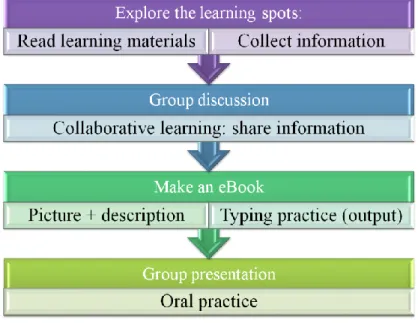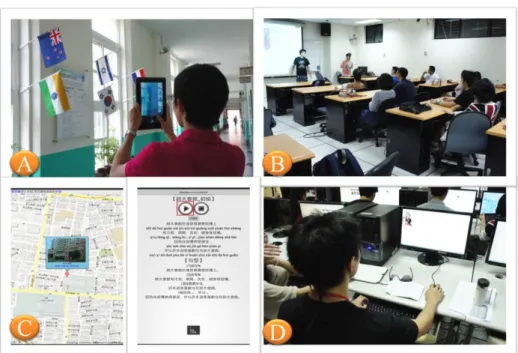Wang, S.Y. et al. (Eds.) (2013). Proceedings of the 21st International Conference on Computers in Education. Indonesia: Asia-Pacific Society for Computers in Education
A Cooperative Learning Platform for
Context-aware Ubiquitous Learning: A Pilot
Study of Mandarin Chinese Learning Activities
Szu-Yun WANGa, Yu-Ju LANa*, Yao-Ming YEHb, Jen-Shing LINa, Yao-Ting SUNGc
a
Department of Applied Chinese Language and Culture, National Taiwan Normal University, Taiwan
b
Department of Computer Science & Information Engineering, National Taiwan Normal University, Taiwan
c
Department of Educational Psychology and Counseling, National Taiwan Normal University, Taiwan
*yujulan@gmail.com
Abstract: This pilot study aimed at examining the effects of a context-aware ubiquitous system on oversea Chinese students’ Mandarin Chinese learning. The research was undertaken on 49 CFL learners of Chinese descent, with whom we conducted interviews regarding their experience using the mobile learning system. It was discovered that the CFL learners found the new learning system both more interesting and informative than conventional teaching methods, but also pointed out several correctable flaws and technical defects which hampered the learning process.
• Keywords: Mobile learning, app, eBook, CSL, CFL, cooperative/collaborative learning
1. Introduction
Due to the rapid development of technology and the increased population of wireless communication, research about mobile learning (m-learning) has been conducted increasingly over the past decade (Hwang & Tsai, 2011). They have also pointed out the importance of further study on m-learning to facilitate learning.
M-learning is also proven to benefit learning in many aspects, such as increasing young adults’ motivation (Attewell & Webster, 2004). Hence, using mobile devices to support learning has raised more open possibilities for learners to access learning activities anywhere and anytime with the assistance of supportive learning materials and real-time feedback (Lan, Sung & Chang, 2007). Furthermore, Lan et al. (2007) suggested that m-learning reduces learners’ stress in cooperative reading activities, and particularly low- and medium- level learners showed a high level of concentration on reading tasks.
Therefore, the purpose of this pilot study was to examine the effectiveness and viability of a new Mandarin learning system in development for use on mobile devices, and to promote a more effective system for Mandarin learners.
2. Methodology
2.1 Participants
Forty-nine teenagers of Chinese descent from mostly Europe and America, whose first languages (L1) or home languages are not Mandarin, participated in the pilot study. Due to their family background, most of them have one or two parents from a Chinese speaking country, such as China or Taiwan. Some of their parents or other family members speak Mandarin to them. However, they have fewer opportunities to read and write Chinese due to the general environment in their own countries. Thus, their Chinese oral proficiency might be near fluent while their Chinese written language (reading and writing) and vocabulary size are relatively limited.
This pilot study used a qualitative approach to investigate how effectively the new system works by conducting an experiment where Chinese learners utilized the system to finish a collaborative learning activity. This experiment allowed us to pinpoint what needs to be improved and changed in the system of both learning process and technical issues.
2.3 Instrument
In this experiment, we designed a Mandarin learning activity designed for use on a recently developed Mandarin learning app for mobile devices as well as for the eBook platform on computer for Chinese as Second Language (CSL) learners (see Figure 2-c for the system screen shot). Each student was given a tablet computer (Eee Pad Transformer Prime TF201) and had access to the lab computer to finish the learning task they were given.
2.4 Procedure
The participants were given a training session before the formal learning activity. After the training session, the participants were divided into small groups of 3-5 people. The formal activity proceeded as the following illustration:
Figure 1.The process of the designed learning activity.
Field Notes – From the Observers’ Perspective
The researchers took filed notes of every small group in every class regarding the phenomenon they had observed during the whole learning activity, which included the technical issues they had encountered, learning problems they had experienced, and all circumstances they had observed.
Semi-structured Interview questionnaire
After the learning activity, participants were randomly chosen and interviewed after the learning activity to investigate their attitudes toward the learning system and materials. Some open-ended questions were designed for this semi-structured interview regarding the following aspects: participants’ background, how they felt about the learning activity, if the learning materials were suitable, if the app and eBook system were user-friendly and what flaws and technical defects were there we can revamp to improve the learning process.
Figure 2.The pictures taken during learning activity.
3. Results
From this pilot study, we have learned valuable facts which continue to help us improve this learning system.
3.1 Interesting and Attractive Ideal to Learn a New Language for Young Adults
Most participants in this experiment liked the idea of the learning activity and referred to it as “interesting and useful”. Due to the trend of the increasing population of smart phones, mobile devices such as tablet computers are not foreign to young learners. Participants pointed out that this learning activity was amusing to them because it involved more engaging exercises than traditional classroom. For instance, many participants enjoyed taking pictures and exploring the learning spots because it was interesting and “special” to them. Some of them mentioned that they practiced more in speaking in Chinese presentations, and making an eBook offered them more opportunities to practice in typing Chinese characters, which are less taught in traditional classroom but useful in practice.
The idea of mobile learning is attractive to teenage students, and most of them thought this learning system was recommendable, especially if some current issues could be solved. However, as previously mentioned, we have also noticed some issues from both the users’ and observers’ perspective. The following presents these issues from both the aspects of learning material design and technical issues.
3.2 Technical defects and flaws that require improvement
3.2.1
Learning Material issues
The learning materials need to be simpler and more supportive.
There was not enough time to finish the reading materials of the learning spots.
The reading materials need to be less complicated or shorter since reading Chinese characters could be time-consuming for non-native speakers.
The learning material design need to suit students’ interests so students could be more motivated. Technical issues
A clear guild line is needed to lead users about how to use the app and eBook system.
Internet quality is important for mobile learning in this case. The participants encountered the problem of being disconnected from the internet and thus needed to keep re-connecting. Because of this issue, the learning activity kept getting interrupted.
To avoid the internet issue, the system needs a mechanism that will automatically save pictures on the mobile device, and then later upload them when an internet connection again becomes available.
4. Conclusion
This pilot study provides a great opportunity to evaluate the new Mandarin learning system in
development from both instructors' and users' perspective. It provides a good starting point for both the learning material design as well as for the development of the app and eBook system.
However, there is still much room to improve this learning system. By examing the flaws and issues with the initial system design, we will be able to draw guidelines that lay the foundation for an even better future iteration of this teaching method.
Acknowledgements
The authors would like to thank the National Science Council of the Republic of China, Taiwan, for financially supporting this research under Contract Nos. NSC 101-2511-S-003-031-MY3, 101WFA0300229, and NSC97-2631-S-003-002. The authors also want to thank the Ministry of Education of the Republic of China, Taiwan, for financially supporting this research under Aim for the Top University Plan."
References :
Attewell, J., & Webster, T. (2004). Engaging and supporting mobile learners. In Proceedings of MLEARNING 2004: Mobile learning anytime everywhere (pp. 15-20). London, UK: Learning and Skills Development Agency.
Hwang, G. J. & Tsai, C. C. (2011). Research trends in mobile and ubiquitous learning: a review of publications in selected journals from 2001 to 2010. British Journal of Educational Technology, 42, 4, E65–E70.
Lan, Y. J., Sung, Y. T., & Chang, K. E. (2007). A mobile-devices-supported peer-assisted learning system for collaborative early EFL reading. Language Learning & Technology. 11(3), 130-151.

